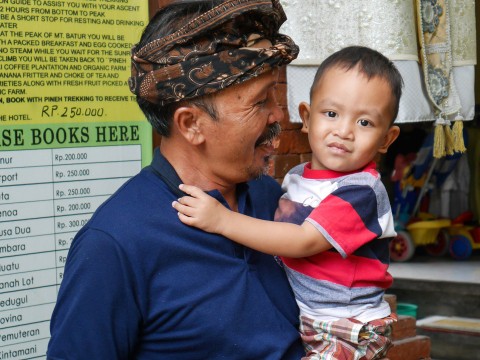Visitors to Bali often recognize Lake Batur as a beautiful lake in the centre of Bali, but very few know the origins of the sacred water source. Of course, though everything can be explained by science now, the Balinese have a folk story regarding the origins of Lake Batur. It’s the story of the helpful but gluttonous giant, Kebo Iwa.
The mythical giant Kebo Iwa, whose first name literally means “ox”, is an iconic figure in old Balinese stories. Kebo Iwa is generally described as a gigantic figure who is generally good and gentle, but can become destructive if not given enough food. It’s also believed, based on archaeological evidence, that Kebo Iwa actually refers to a Balinese warrior that had close connections to Gajah Mada the legendary general known to have united Indonesia in the fourteenth century. For now, here’s the folk story of how Lake Batur came to be.
Once upon a time, in a Balinese village, there lived a giant named Kebo Iwa. Being a giant, he had massive strength and also a massive appetite. The people in the village often asked Kebo Iwa’s help to build houses and repair temples. Kebo Iwa never asked for any money in return; he just wanted the villagers to prepare food. A lot of food, equivalent to the portion of 100 adults. The villagers had a hard time preparing that much food, even if Kebo Iwa did nothing that particular day. If the villagers failed to provide food, Kebo Iwa would become angry and destroy houses and temples. The food supply in the village gradually declined and people started to go hungry, except for Kebo Iwa.
One day, the village was struck by a long draught. The rice fields were dry and filled with wilting rice plants. As the food in the village storage dwindled, the villagers started to fear Kebo Iwa’s wrath. He had to be fed constantly, but there was no harvest this year!
Their fears were realized. Kebo Iwa appeared before them one day, demanding for food. Seeing that the villagers could not provide food to satiate his bottomless maw, he began to rampage through the village. He destroyed houses and temples and ate cattle. Everyone fled for safety, terrified of Kebo Iwa’s power. But, as they saw their sacred temples being reduced to rubble by Kebo Iwa’s might, the villagers’ fear evolved into vengeance. “How dare he destroy our gods’ dwelling!” said the village chief. So, the villagers cooked up a plot to get rid of Kebo Iwa.
After the rampage, Kebo Iwa was tired. The villagers approached him, with loads of food they managed to scrounge up. Kebo Iwa gobbled up all the food and made a deal with the villagers. He would help them rebuild, and they will provide food for him from thereon. Lulled by the promise of eternal food, Kebo Iwa gladly accepted the offer.
Kebo Iwa kept his word. He helped the villagers rebuild the temples and houses. Owing to his strength, half of the village was rebuilt in a matter of days. While he was working, the villagers were secretly gathering limestone. A lot of limestone. “After you rebuild our village, we’re going to build you a big, luxurious house!” said the village chief. Kebo Iwa was delighted. He worked harder.
After the village was fully rebuilt, Kebo Iwa’s final task was to dig a well so the villagers could have enough water. He dug and dug and dug. A mountain of earth began to form. The villagers kept providing food for him as he continued digging.
One day, Kebo Iwa fell asleep in the hole. He ate too much and was exhausted. Upon hearing his snores, the villagers knew it was their time. They started dumping the limestone into the well. Kebo Iwa was fast asleep. He woke up when he realized he was suffocating on water mixed with limestone. He jolted awake, struggling to keep above of the rising water. But, despite his strength, he could not escape the sticky mixture of limestone and water. He could only scream and writhe, until he met his demise, buried under water and limestone. The villagers cheered, they were finally free from their oppressor!
The well that Kebo Iwa dug is now known as Lake Batur, while the massive heap of earth standing beside it became known as Mount Batur. And that’s how Lake Batur came to be, according to Balinese folklore.
Balinese parents often used stories like these to educate children about moral and cultural values. In this case, the moral of the story is to always act nice to other people by helping without expecting your due. We hope you enjoyed it!




